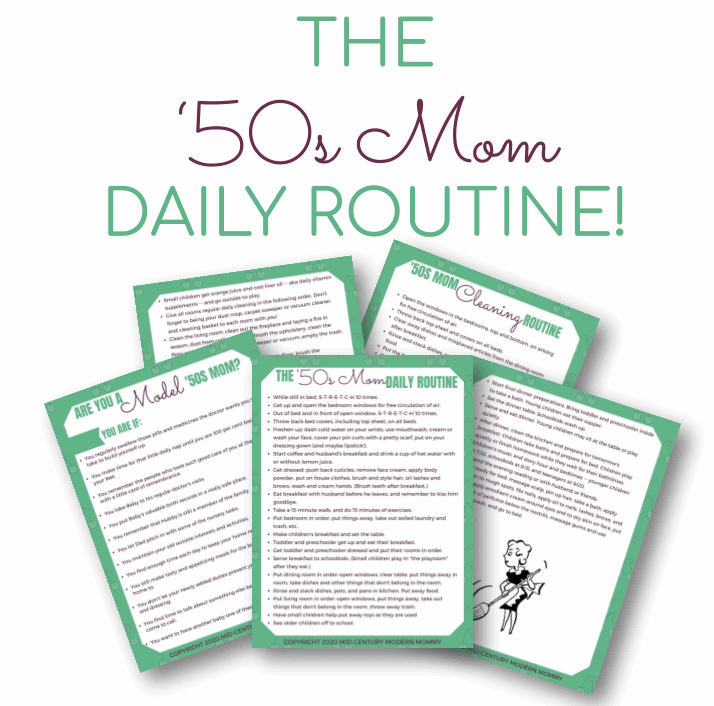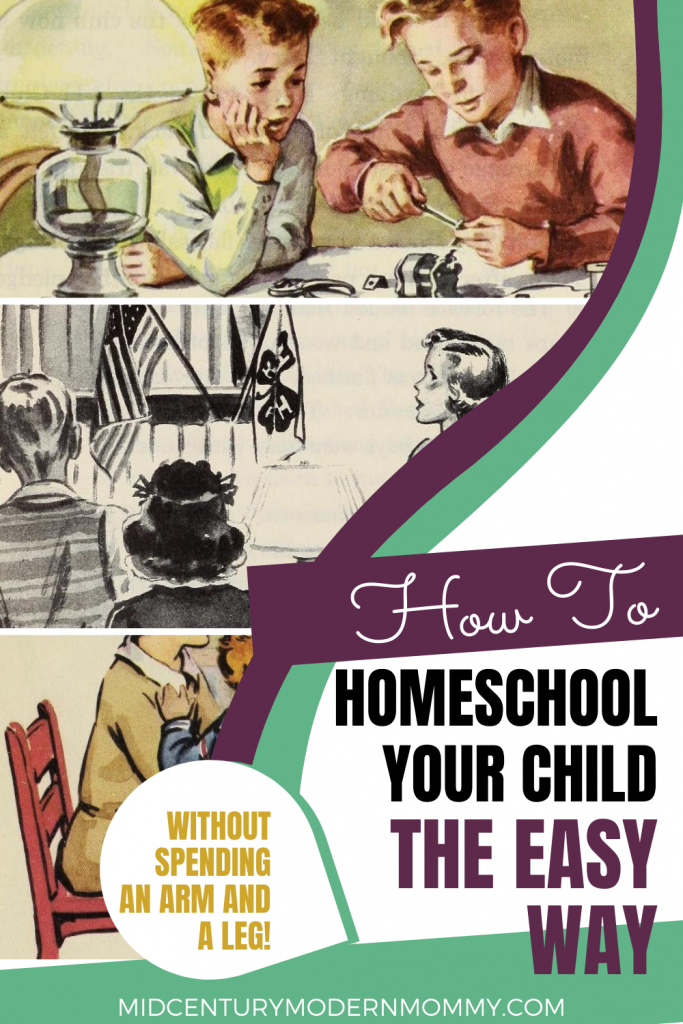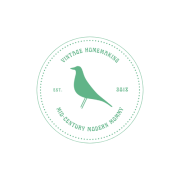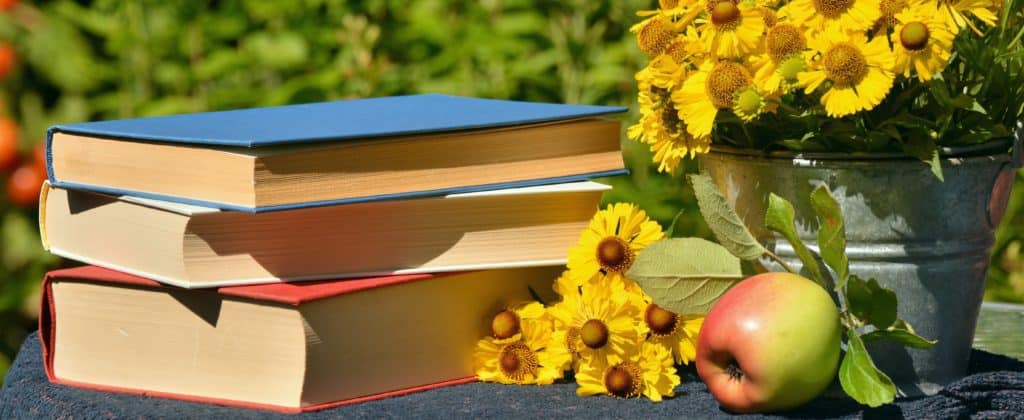Even if you’ve been the one taking care of that precious baby since he was born, you’ll usually start stressing when he hits 4 years old. Should I homeschool him? CAN I homeschool him? HOW???? Add a few more babies into the mix, and it becomes even more daunting! How can you possibly find the time to keep up with all the babies and the housework, and start homeschooling your kindergartner?

Get Our Mid-Century Mom Daily Routine FREE!
Homeschool the Easy Way
Let me tell you, I always knew that I was going to homeschool my kids. What I didn’t know was HOW. Honestly, I wanted a one-room schoolhouse with Laura Ingalls Wilder in the next desk over. But that wasn’t going to happen! I wanted a way to start homeschooling my oldest with vintage books. And I wanted it to be simple because I already had two younger children with special needs.
What is so HARD About Starting to Homeschool?
This post contains affiliate links. If you click a link and make a purchase, I may receive, at no additional cost to you, a small commission. Find out more on my Disclosures page, and thank you so much for your support!
The idea of being completely responsible for making sure your child is educated is terrifying! At least if you send them to school, you can blame the school if you don’t like the result. When you homeschool, all the blame comes to rest on you. (All the praise comes to rest on your child!)
It can be especially overwhelming when you don’t have a roadmap. That’s why a lot of parents start out by picking a method, or even a full curriculum. It’s reassuring that someone else is telling you, “Homeschooling is hard; here’s how you do it.”
How Do I Start to Homeschool Kindergarten?
The basics of education are skills. Skills include reading, writing, math, drawing, and memory; they need to be practiced every day. There are also some non-academic skills that should be practiced every day: music, physical education, practical/decorative arts, and play. Everything else is just content.
The non-academic skills make up the majority of early learning, from birth to kindergarten. In fact, I don’t even start my academic skills in kindergarten! I don’t start them until first grade. (But if you’re wondering just how to go from the alphabet and numbers to reading, writing and doing math independently by second grade, try the RC for Littles course!)
Reading
Reading is about being able to gather and understand information. It starts with the alphabet and phonics (unless you’re learning Chinese . . .), then it continues with practicing reading every day and learning to understand what you read. (Listening is also part of reading skills, which is why dictation is included.)
Writing
Writing is about learning to communicate your ideas and express your thoughts. It starts with learning cursive writing (especially for children with learning disabilities) and copying good writing every day. It also means learning to speak and recite — what used to be called elocution. And eventually, it leads to writing whole essays.
Math
Math starts with math facts — the “phonics” of math. Math is really just another language, a symbolic language. And it will eventually lead to logic and physics. But for most parents, it is the subject they most dread teaching. (Keep reading if this is you; there is hope!)
Memory
Practicing memorizing and reciting every day is a skill that falls into ALL the other skills. You have to memorize phonics and math facts to read and do math. But you also need to memorize the facts, dates, information and beliefs that make up your cultural heritage. This is where you define the canon of content that you want your children to inherit.
What books will you read? What dates will you memorize? What scientific achievements, religious principles, or historic events will you discuss? For example, the curriculum I use includes books with various stereotypes. This provides me with the opportunity to discuss stereotypes, judging others as groups instead of individuals, and the principle of Christian love. The books also include behaviors that I consider immoral or unacceptable — more opportunity for discussion and teaching!
Drawing
This is where I differ from a lot of other curriculum recommendations. I recommend teaching drawing like teaching writing as a way to develop the ability to observe. Observation is at the heart of all the sciences, as well as a crucial part of creating new technology; it’s becoming one of the most important things we can teach our children.
The best way to teach drawing is similar to teaching writing. Begin with the alphabet of drawing — the basic shapes. Move on to copy work of increasing complexity. Then on to making original works.
Best Products to Easily Homeschool Your Child
Now, I don’t know about you, but I have WAY TOO MUCH life going on to be able to spend all my time homeschooling!
Seriously, I love the idea of Charlotte Mason and classical homeschooling, but I’m not a teacher, and I have housework, a home business, babies and toddlers — even a homesteading husband!
So I need a way for my children to be able to teach themselves. And as we have seen this year, it is REALLY helpful to have kids that can teach themselves, because they can shift to an online environment for their classes and be successful.
But, it can be intimidating. I mean, how, exactly, do you go from learning the alphabet to reading fluently? Or from learning numbers to algebra? Well, here are the best products I have found to make it easy.
This post contains affiliate links. If you click a link and make a purchase, I may receive, at no additional cost to you, a small commission. Find out more on my Disclosures page, and thank you so much for your support!
Teaching Children to Read, Write, and do math
If you just feel completely lost about how to teach your children to read, write, and do arithmetic, then I recommend Karen’s Robinson Curriculum Course for Littles. She has videos to teach you exactly how to teach all three things, using easily available resources.
She actually teaches her children almost exactly the same way that I do. The main difference is that I only teach my children cursive, and instead of using Alphaphonics to teach reading, I go straight into the McGuffey’s Primer — although I use the same method.
Although she teaches the course for parents who are just starting out with Robinson Curriculum, I recommend this course to everyone who is unsure about how to teach their children. She is great! And her method uses freely available vintage books (especially if you substitute Mcguffey’s for Alphaphonics! (This is my affiliate link, by the way. If you use it to purchase Karen’s course, send me a copy of your receipt by email, and I will send you a copy of my homeschool schedule printables free — a $7 value!)
A Solid Curriculum to Build Independent Learners
The number one choice for an easy minimalist curriculum that is wholly designed to guide your homeschoolers to be independent learners is the Robinson Curriculum. It is the BEST!
Now, a lot of people have objections to things like the “no TV, no sugar” rule that accompanies this curriculum. Let me tell you something. My husband is a GAMER. So are my teens. No screens is just not an option in my house. And I’m a ’50s housewife. You think I’m going to give up sugar? Really? Seriously, I make dessert for lunch and dinner. And cookies after school.
But guess what? THE SYSTEM WORKS ANYWAY. It’s the system that this curriculum is based on. And it woks for college prep. This method is DESIGNED to get your kids into Cal Tech. It works. It works for good colleges. BUT it also leaves plenty of time for your teen to focus on things that interest them. And it has a very solid math and science curriculum. method.
So, the Robinson Curriculum is always my number one recommendation to anyone who wants to homeschool their children and have it turn out successfully. And if you want an introduction to Robinson Curriculum, Karen also has a really excellent video series on the curriculum that I recommend.
Drawing
So, this is a little tricky. I am creating my own drawing curriculum as I go along. For now, I start with What to Draw and How to Draw It by Edwin Lutz, which is a vintage drawing book that is based on shapes and lines. Then I go on to Lutz’s Drawing Made Easy.
After that, I have them alternate between Lutz’s Practical Drawing and copying great works of art. The method that I use for drawing copywork, at first, is to have the student draw a simplified line drawing version of a great work of art from a Dover coloring book. (If you’ve never used Dover coloring books, they are real gems.) I also have them start copying maps. Copying maps until you can draw every continent in the world is a great way to learn geography!
After that, they are free to keep a field journal or draw as they wish. I do keep some field guides around for them to copy from, though!
Science
One thing about Robinson Curriculum is that the children of Dr. Art Robinson grew up on a farm. So they didn’t need a nature study. If you live on a small homestead, and you have a garden and a few animals, your kids don’t NEED nature study.
If you live in a city, you might want to include nature study. I recommend encouraging your child to keep a field journal and make collections while taking a regular nature walk and keeping field guides on hand to read.
Physics and chemistry are included in the curriculum. I also include a course in computer science and programming with Khan Academy for my kids when they reach high school.
As far as books, I keep Julia Rothman’s books on hand for the children to study. I also keep field guides around and encourage the children to look things up, just like an encyclopedia or dictionary.
Memory Work
Honestly, I just use Classical Conversations memory work. I don’t use their curriculum system, but the memory work is good. Robinson Curriculum also comes with vocabulary memory work, and I include that. The only other thing that I add is the Westminster Shorter Catechism. I recommend adding whatever you think will instill your family culture into your children. Some people even use Christendom Curriculum.
Advanced Studies for Independent Learners
As far as advanced reading and writing, I recommend that if you have teenagers in middles or high school, that you invest in the courses from Dr. Fred Ray Lybrand. His reading and writing courses are AH-MA-ZING for teaching children to develop college-level skills. He also has a great course that shows you how to get your active homeschool teaching done in 30 minutes a day after the basic skills are learned. Fantastic!
Another advanced study is learning a foreign language. Now, I am old-fashioned. My language arts curriculum in ANY language is phonics, grammar, and reader. And I prefer vintage books. So, to supplement the Robinson Curriculum with foreign languages and language arts resources, I use the vintage textbooks from Dollar Homeschool.
The BEST Kindergarten Curriculum
Now, I haven’t said much about kindergarten, but the ABSOLUTE BEST RESOURCE for a vintage kindergarten experience is a set of vintage Childcraft books. Every day, read to them for 15 minutes from the books and do an activity (singing, crafts, science) from the books. By the end of the year, they’ll have had a complete kindergarten curriculum. Add some coloring books, and read them classic picture books at bedtime. I also let my little children listen to Wee Sing during their playtime. And they get to watch Mr. Roger’s Neighborhood, 1 episode a day, which is currently available through Amazon Prime.
The Minimalist Guide to Homeschooling the Easy Way
How Do I start Homeschooling?
Go to HSLDA.org and check on what local homeschool laws are. Then notify your state’s Department of Education that you are homeschooling your children.
What Do I Need to Start Homeschooling?
Pencils and paper, or chalk and chalkboards if you are all about zero-waste. Other things are nice to have, but you can teach reading, writing, and arithmetic with just something to write ON and something to write WITH. That’s it.
How Can I Homeschool For Cheap Or Free?
The resources that I linked above are the best value available. Using them, you can homeschool all your children through high school — for less than the cost of education ONE child for ONE year in the public school system.
That said, if you have absolutely no money, check out DonPotter.net or Internet Archive for links to vintage and free resources to learn the important stuff, and spend your money on paper and pencils.
The Last Thing You Need to Know about How to Homeschool the Easy Way
You can homeschool your child, and it won’t take a ton of money or time.
It’s really easy to teach your kid to read write, and do arithmetic.
And finally, if you are STILL wondering how to get everything done every day, check out my simple homeschool schedules for each grade. Or sign up below for my mailing list and get a free ’50s Mom Daily Routine





Love the way you broke down all the options to homeschool. These are scary times for sure but, also, as you said, when your child reaches about 4 this question comes up. Great article – thanks!
Thank you!